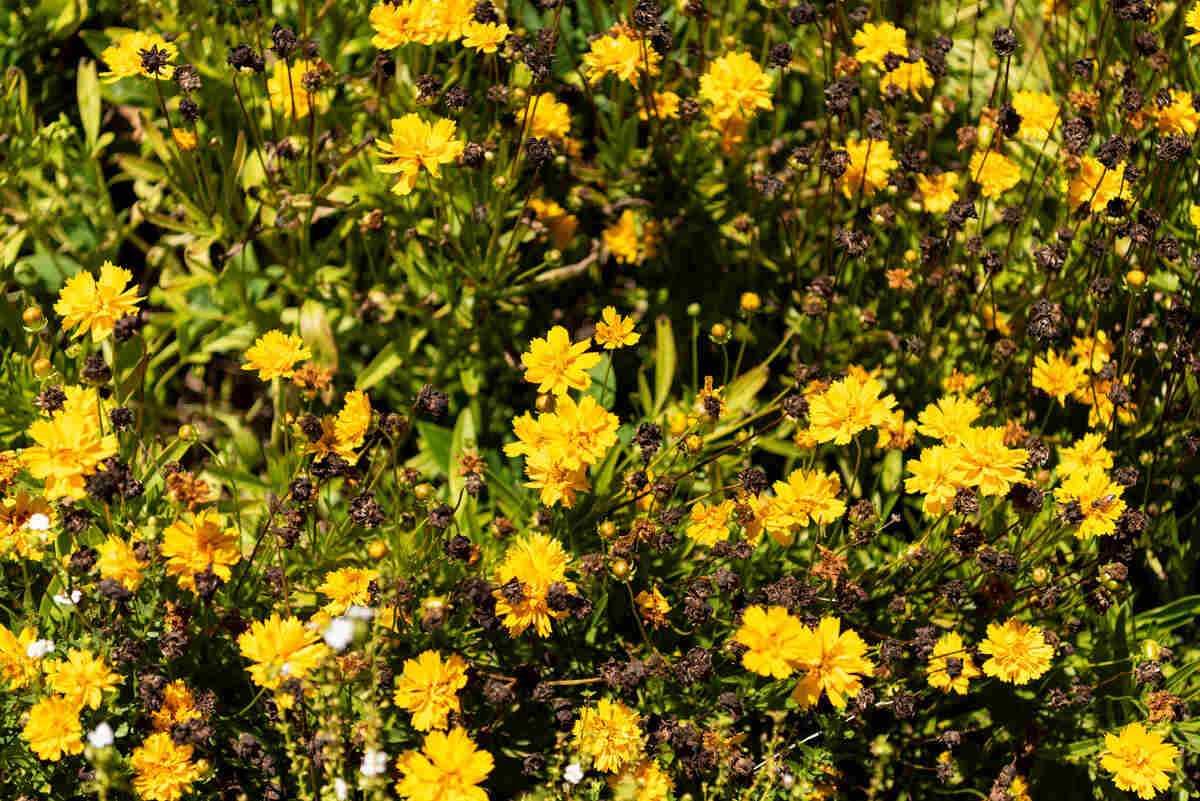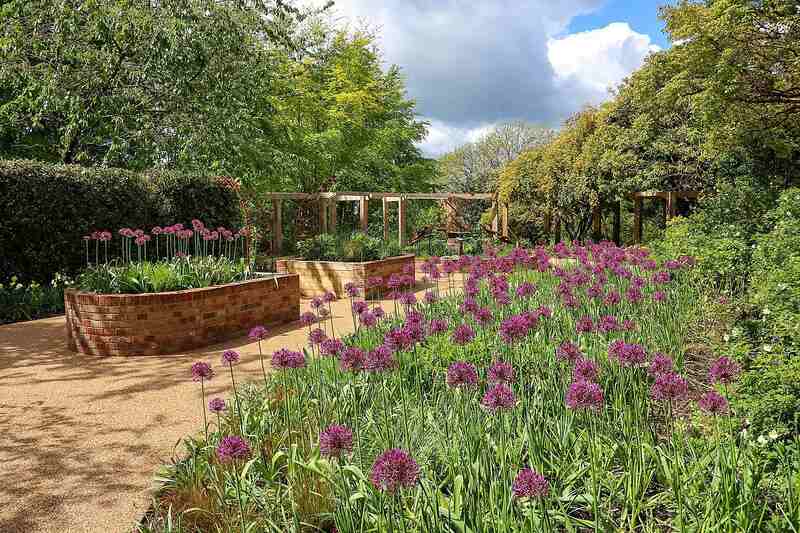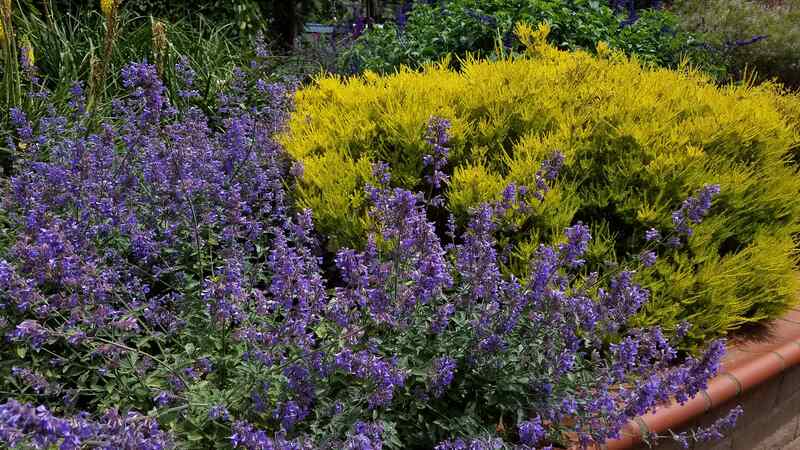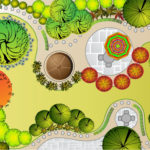
What is a sensory garden? A sensory garden is an outdoor space with various plants and other elements that stimulate, heighten, and engage your five senses — sight, sound, taste, touch, and smell.
Envision yourself in a flourishing garden – the aroma of mint fills the air as your bare feet crush the cool, soft leaves. To your left, you hear the bubbling water of a beautiful white fountain and watch hummingbirds dart across pink, purple, and yellow blooms.
As if in a trance, you pluck a tiny dark purple and white pansy petal, pop it into your mouth, and marvel at its lettuce-like sweet taste.
That is a sensory garden. In this article, we’ll show you how sensory gardens activate all of our senses, and we’ll cover the benefits of sensory gardens, too.
- What’s in a Sensory Garden?
- Garden Components That Activate the Senses
- What are the Benefits of a Sensory Garden?
- Who Would Benefit From a Sensory Garden?
- FAQ About Sensory Gardens
What’s in a Sensory Garden?

A well-thought-out sensory garden design should include interaction with all of the five senses along the way.
Gentle winding footpaths with different materials would guide you to explore and enjoy the garden’s atmosphere. Along those paths should be well-placed benches with water features, providing opportunities for rest to take in the scenery and immerse yourself in the sounds of the flowing fountain.
Plants should surround you with their vibrant colors, delectable scents, and opportunities to taste wild edible berries.
Other garden areas might highlight “flora and fauna” (referring to all plants and animals on Earth) using the plants that attract hummingbirds, bees, and butterflies to pollinate and drink nectar.
Bird feeders and birdbaths would be cleverly situated so our feathered friends can wash and then feast comfortably.
Sensory gardens feature colorful, fragrant, edible plants and other design components like water features, wind chimes, and textured stones.
Sensory gardens offer a unique experience in which you can take in the sight, sound, touch, taste, and scents that lead to relaxation and enjoyment. These gardens aim to promote mindfulness for everyone.
These wonderful outdoor spaces also provide therapeutic and educational opportunities for those with disabilities or mental health issues, making them an ideal environment for socializing and therapy.
Special touches such as dog-friendly features can add to the experience of exploring the garden.
“Design Intent” is what sets a sensory garden apart from other types of gardens. A sensory garden should almost feel like you are in the audience watching a performance (lights, action, camera) by Mother Nature.
Here are some elements of a sensory garden that would appeal to each of the senses:
Garden Components That Activate the Senses
Gardens can offer an experience for all five senses. Here’s how:
— Colorful plants of differing heights and varying bloom times create visual year-round interest
— Birdbaths, and bird feeders bring different species of birds to your garden
— Specific plants draw butterflies, bees, hummingbirds, and dragonflies
— Wind spinners delight both the eyes and ears
— Birdbaths
— Water fountains and water walls
— Ponds and bog gardens with water lilies attract frogs, crickets, cicadas
— Wind chimes
— Fragrant plants
— Herbs
— Evergreen shrubs/trees like pines
Touch
— Plants with texture
— Hardscaping elements like smooth stones and benches that are made of wood or granite/marble.
— Grass that you can walk on barefoot
— Misting machine in the summer to cool visitors and experience a rain garden-type feel
— Edible flowers
— Herbs
— Vegetable garden
— Fruit trees
Sense of Sight
Gorgeous blooms with varying bloom times will create year-round interest, and native plants invite butterflies, bees, and hummingbirds to draw near.
Flowering deciduous shrubs, perennials (plants that come back year after year, usually in late spring or early summer), and ornamental grasses offer different textures, colors, and “habit” (plant shape and how they grow) for visual viewing pleasure.
Geranium (Pelargoniums) and sunflowers give a brilliant pop of color and have interesting textures.
When planted in a hierarchy emphasizing differing heights, tallest in the rear, middle-sized plants in the middle, and smallest in the front, visual interest peaks even more.
Birdbaths and bird feeders attract many species of birds. It’s fun to watch them come and go. Bird enthusiasts would delight in identifying their favorite species.
Wind spinners can create a dynamic experience that is visually appealing, depending on how strong the wind blows.
Sense of Sound
Relaxing to the sounds of water has been proven to reduce stress and induce a sense of serenity. Whether it be a bubbling brook, flowing fountain, small pond, or water wall, immersing oneself in these natural calming sounds can benefit mental well-being.
A sensory garden can become a lively auditory experience with the sounds of wildlife. During the day, birds sing, crickets chirp, and at dusk, cicadas create a chorus.
If you’re lucky enough to have a pond nearby, frogs might join in with their croaking tunes! Every species brings its own unique sound to nature’s orchestra.
Wind chimes can be used to create a calming ambiance out in the garden. They bring uplifting energy, connect us to nature and invoke positive emotions.
Feng shui practitioners, meditators, and sound therapists all appreciate the soothing quality of wind chimes and their ability to help work through any lingering negative emotions.
Sense of Smell
Sensory gardens loaded with fragrant plants provide several benefits for us. These plants create pleasing aromas, and some possess healing properties, making them an excellent choice for those looking for an emotional and physical boost.
Fennel, sage, gardenias, and other fragrant garden favorites can be included in any sensory garden design to create a truly special experience that is memorable, peaceful, and therapeutic.
Herbs offer a range of tactile and olfactory experiences. Mint and bayberry, for example, exude intoxicating fragrances when crushed between your fingers!
Have you ever taken a stroll in the woods and come upon a grove of pine trees? Ahhh. The calming smells of pine can reduce stress and boost mental health. Pine trees have been used in sensory gardens for centuries to help create soothing and calming environments.
Sense of Touch
The tactile sensation is important in a sensory garden. Soft flowers, fuzzy leaves, rough bark, prickly seed pods, and springy moss provide tactile experiences that help “ground” visitors in their environment.
Areas where you can walk barefoot, like on a moss lawn, help add to the experience.
A misting machine along a garden path would add delight and refreshment on a hot summer day.
Incorporate a variety of tactile plants into your sensory garden! Furry lamb’s ear leaves, tall smooth bamboo stems, plush vinca beneath your feet, and succulents with their thick and fleshy tissues create juxtaposition for an enchanted outdoor space.
Hardscaping, or the non-living design element of a garden, is an important part of building a sensory garden. These might include sitting, standing, and climbing areas that offer different textures to explore.
Furthermore, sensory pathways may be made with various materials like sand, flagstone, wood chips, or even flat stepping stones with smooth textures.
Sense of Taste
Edible flowers can be a fun addition to sensory gardens! Whether you are looking for colorful flowers or edible leaves and stems, there are plenty of options to choose from.
Nasturtiums, pansies, violets, hosta, borage, and calendula offer a variety of flavors for your palate that are frequently used in culinary dishes or teas. Echinacea, also known as coneflower, has medicinal qualities when used in tea.
Edible flowers provide both visual beauty and delicious taste!
Herbs also fall into a couple of sensory categories — the category of sense of taste, smell, and texture
Where would we be without brilliant basil for pesto sauce or tantalizing thyme on some chicken? Lavender, rosemary, mint, and sage are heavy hitters regarding flavor. These are all excellent choices for a sensory garden.
Bee balm provides a citrusy flavor, and allium sports an onion flavor.
But herbs are more sensory than just taste. Basil also pleases the nose, and brushing your hand over parsley lightly tickles your fingers and palm.
Adding a vegetable patch and fruit trees to every sensory garden is a fantastic way for you, your family, and any visitors to connect more with nature.
Depending on your region, apples, pears, lemons, oranges, tomatoes, and lettuce could all be part of the patch or groves of fruit trees. This would allow visitors to sample different fruits and veggies from the sensory garden.
What are the Benefits of a Sensory Garden?

A sensory garden has many benefits, from the beauty they create to the ecological advantages they provide. Here is a list of some of the benefits of a sensory garden:
- A unique space for stunning social gathering spaces.
- A fantastic tool for learning about local native plants, herbs, veggies, and fruit.
- Help promote mindfulness and meditation via a peaceful ambiance and natural setting.
- Perfect for providing habitats for native flora, fauna, and pollinators such as butterflies and bees.
- Provides an opportunity to get out and enjoy the great outdoors.
- Offers a natural pollinator-friendly habitat free from the use of pesticides, herbicides, and other toxic chemicals.
- Gets kids away from their screens, electronic devices, and social media. Get them into the sunshine and fresh air, helping them decompress and explore nature.
- Provides a calming atmosphere and can offer therapeutic benefits.
- Immerses you in a “multimodal” world to forget about your life challenges for a while.
- Elderly people can have a nice walk and get some exercise.
- Being outdoors helps with sleep.
To help you grasp the concepts of some of the elements of a sensory garden, here are some scenarios that you might have experienced yourself without ever stepping foot in a sensory garden:
Have you ever experienced the tactile sensation of eating a peach? Nothing can quite compare to the experience of sinking your teeth into a juicy ripe peach. The soft and fuzzy skin gives way to the sweet flavor of the flesh, with almost syrup-like juice dripping down your chin.
Enjoying this delicious fruit is truly a sensory delight! It may remind you of your grandma’s kitchen as she baked a peach pie.
Have you ever stepped into a patch of mint barefoot? If you had, you would delight in the intoxicating aroma of mint as it releases its scent when walked upon. You can also enjoy the soothing essence by crushing the aromatic herbs between your fingers.
The aroma might flood your mind with memories of your aunt’s veggie and herb garden.
After it rains, do you ever feel the urge to go out and walk in puddles with your bare feet? It’s a fantastic feeling — cold water washing against your skin, the brisk clean air around you erasing all worries as you take a moment to enjoy the freedom of being immersed in nature.
Walking in the puddles barefoot may remind you of childhood friends.
Any of the above sensations will help you appreciate the benefits of a sensory garden, as you will encounter some of the same feelings.
Who Would Benefit From a Sensory Garden?
That is a great question! Here are some people (you and others) who would benefit from a sensory garden:
- If you are a homeowner with an empty backyard space and want to entertain your five senses.
- If you have children and want to teach them about the five senses through an interactive environment specifically designed for that purpose.
- If you have elderly parents or grandparents you’d like to get outside because they are housebound.
- If you know someone with disabilities who would just enjoy an extraordinary immersion into the sensory world.
- If you have a dog and a big enough area on your property, this type of garden will provide the fuzzy babies with a heightened sense of exploration, play, and relaxation.
- Finally, you just need a tranquil oasis to escape and contemplate life’s next moves
Just remember that if you live in the northern hemisphere, your sensory garden will go dormant during the winter months. Your perennials will disappear beneath the ground. You will want to account for interest during the winter months. A good example of a flower that blooms in the cold is Helleborus (Christmas Rose) — this perennial shows itself when all the other flowers are dormant.
FAQ About Sensory Gardens
There are so many types of gardens, each designed with a different purpose to achieve a different result. While traditional gardens may typically focus on sight or smell, sensory gardens have been designed to stimulate all five senses — sight, smell, taste, touch, and sound.
Sensory gardens are characterized by including plants of different shapes and colorful foliage, aromatic flowers, and other features like sculptures, paths, and water features to provide a multi-sensory experience.
Other gardens take a different approach and focus on one sense, like vision, or aim to create a particular emotion in visitors. There are just too many types of gardens to list, so I’ve highlighted a few below:
Formal gardens, like the gardens of Versailles in France, are very visual, combining geometric patterns with meticulously manicured plant material. Walking barefoot in the grass or any manicured areas would be frowned upon because the property owners want this garden to remain unblemished and pristine.
The grounds of formal gardens are probably chemically treated to prevent weeds.
“Look but don’t touch”: Unlike sensory gardens, formal gardens are not for “audience participation.”
Zen gardens are renowned for being a place for meditative reflection with thought-provoking patterns raked out in the sand to evoke one’s sense of mindfulness. Unlike sensory gardens, they differ in their approach to experiencing the tactile sense.
It would be frowned upon if you impulsively threw your shoes in the air, ran, jumped, and wiggled your toes in those beautifully raked-out patterns in the sand — meaning the best way to enjoy Zen gardens (like formal gardens) is to look but not touch.
Butterfly gardens appeal to butterflies’ senses to draw them near. Plant material is selected carefully with this purpose in mind. To appeal to the other senses, showcase plants with attractive colors, habits, textures, and smells.
It’s a lovely and memorable experience to have a butterfly just land on you. I’ll never forget and always treasure that special moment when a butterfly landed on my finger.
Container gardening is when plants are grown in containers because space is limited. Patios and balconies with sun exposure most of the day are great for container gardening. You can choose pots of varying size, color, texture, and shape to create visual interest and configure them according to the plants you’d like to install.
Plant material can be chosen to appeal to all five senses with the caveat that certain plants will do well in containers while others will not thrive. Water gardens can also be container gardens.
Demonstration gardens are designed to be educational and help gardeners learn more about local plants and sustainable gardening techniques.
Water gardens, also known as aquatic gardens, utilize water plants and other water elements as the main components in their creation.
Water gardens combine beautiful water plants such as waterlilies and water iris with waterfowl and ornamental fish. Water lilies attract frogs, and koi fish can be used to create an ecosystem within the water garden.
Everyone wants a safe and enjoyable “multimodal” interaction with nature, so pesticides and herbicides must be avoided entirely in the sensory garden, as they can be dangerous and even toxic.
Instead, plants with non-toxic, non-allergenic qualities should naturally pollinate through the help of insects only. If any thorny plants like roses are included in the design, they should be placed out of reach of users at the back of the beds. Young children should be able to roam freely without concerns about being poisoned.
Yes and no. It’s all in the eyes of the prospective buyer and his or her opinion of your sensory garden.
If the prospective buyer appreciates beautiful plants and well-tended outdoor areas, having a sensory garden may make your home more appealing. It could be viewed as evidence that the property is loved and cherished. The would-be buyer even may make a higher offer because they appreciate the beauty and benefits a sensory garden brings.
However, even if the garden is a botanical delight to all the senses, has been meticulously detailed, and resembles the gardens of Versailles in France, it may not matter. If the prospective buyer doesn’t enjoy gardening and sees the sensory garden as just another chore, it won’t improve your home’s value.
Yes, and we’ve listed some of these below:
Asthma, allergies, and hay fever
If you suffer from allergies or asthma, a sensory garden can cause your symptoms to worsen due to pollen count.
As the weather gets warmer and brighter in springtime, outdoor activities become more inviting. Still, it’s essential to factor in the potential triggers of your allergies when planning an outdoor excursion.
Wind-pollinated plants like grasses, weeds, and certain trees can contribute to allergies and asthma. This is because they use the wind to spread pollen from plant to plant and often bloom during springtime.
These sorts of light pollens can travel far distances depending on the prevailing winds or other external factors, so it may be best to avoid or limit including them in a sensory garden.
To combat this, sensory gardens can be designed with allergen-free plants to help reduce pollen levels and provide a safe environment for those with allergies and asthma.
Bees
Sensory gardens are a great way to get closer to nature and enjoy the outdoors, but bee stings can be a potential hazard. Home treatment is usually enough to relieve the pain and discomfort if you’re stung by a bee.
However, emergency medical attention may be necessary to treat anaphylaxis if it’s more severe and you’re allergic or have been stung multiple times.
What is anaphylaxis? Anaphylaxis is a severe and potentially life-threatening allergic reaction that can occur after being stung by a bee or other insect. Symptoms of anaphylaxis can appear rapidly within minutes of being stung and include:
● Swollen lips
● Difficulty breathing with throat closing
● Hives, itching
● Flushed or pale skin
● Dizziness and/or fainting
● Abdominal cramps and nausea
● Loss of consciousness
If left untreated, anaphylaxis can be fatal, so seek urgent medical attention if you suffer from any of these symptoms after being stung by an insect.
Sensory Processing Disorder
Someone with Sensory Processing Disorder (SPD) may have difficulty managing the information he or she receives from their senses. Depending on the individual, this could be oversensitivity or under sensitivity to certain sounds, tactile sensations, tastes, sights, and smells.
As such, it is advised that people with SPD not be exposed to sensory gardens as the heightened amount of stimulation may be too overwhelming for them.
Hire a Landscaping Pro to Create Your Sensory Garden
If you want to create a “multimodal immersive experience” in your yard and have no idea how to begin, contact a local landscaping pro. He or she has the knowledge, expertise, and vision to execute your project based on your location, budget, and site conditions.
Main Image Credit: Bryce Walker / Flickr / CC BY 2.0





